Hardware
Sapphire R7 260X Graphics Card Review
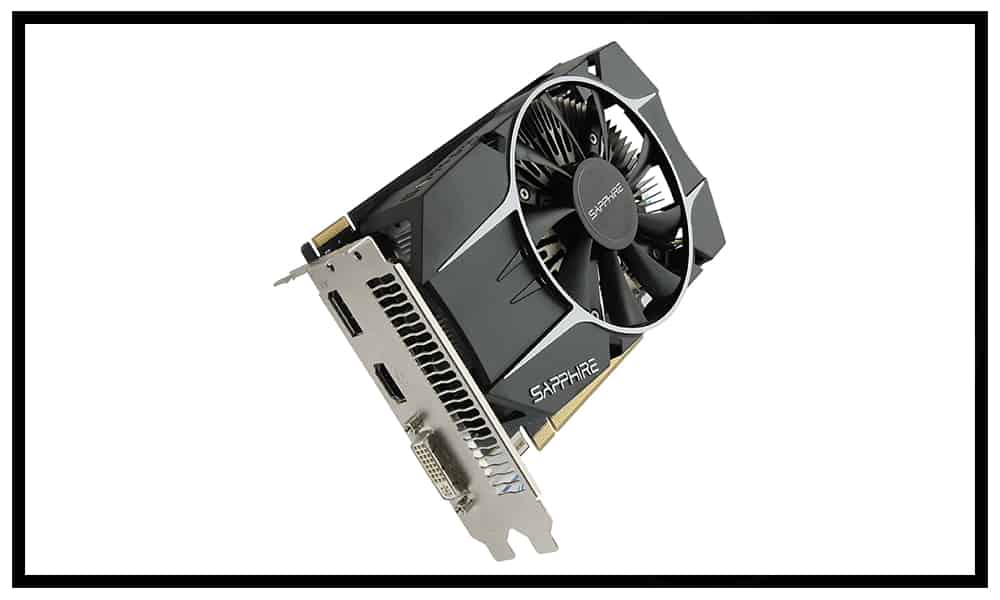
Introduction
In October 2013, AMD released their follow-up to their Radeon HD 7790 that was released the previous April, the Radeon R7 260X. It is built on the 28 nm process and based on the XTX variation of the Bonaire graphics processor. Unlike the HD 7790 that came before it, the R7 260X commonly features 2Gb of graphics memory. The Bonaire graphics processor also has many features that are only shared with AMD’s Hawaii R9 290(X) and Vesuvius R9 295 flagship models. These include TrueAudio Technology and PowerPlay with ZeroCore Power Technology, to name a couple.
When Sapphire asked if we wanted to review their Radeon R7 260X, we happily agreed. They did, however, have one stipulation, we needed to use a more budget-friendly test system than our usual Intel i7-based test system. This makes quite a bit of sense. Most people who purchase a graphics card in this price range are not installing it in a system with a $300+ processor. We chose an AMD FX-6300-based system. The FX-6300 is a $120 processor that is very popular. This review goes one step further than our typical graphics card review by also including base and overclocking results for the CPU as well.
Sapphire’s Take on the R7 260X 2GB
SAPPHIRE R7 260X with new AMD TrueAudio Technology, enable games to feature more realistic environmental dynamics, sound effects, and directional audio. With the new AMD Eyefinity Technology, R7 260X now supports up to 3 monitors. With 2GB of the latest GDDR5 memory and 896 stream processors, and support for DirectX 11.2, the architecture is built to play the very latest games with perfectly smooth action even at higher resolutions.
HDMI (with 3D)
Support for Deep Color, 7.1 High Bitrate Audio, and 3D Stereoscopic, ensuring the highest quality Blu-ray and video experience possible from your PC.
DisplayPort 1.2
Doubling the effective bandwidth of previous DisplayPort implementations, DisplayPort 1.2 now includes support for Multi-Stream, allowing you to drive up to four separate monitors from a single DisplayPort 1.2 connector (requires DP1.2 monitors or Multi-Stream compatible hub), Stereoscopic 3D monitor support and adds support for high quality, lossless, 7.1 channel audio formats.
Dual-Link DVI-I
Equipped with the most popular Dual Link DVI (Digital Visual Interface), this card is able to display ultra high resolutions of up to 2560 x 1600 at 60Hz.
Advanced GDDR5 Memory Technology
GDDR5 memory provides twice the bandwidth per pin of GDDR3 memory, delivering more speed and higher bandwidth.
AMD Stream Technology
Accelerate the most demanding applications with AMD Stream technology and do more with your PC. AMD Stream Technology allows you to use the teraflops of compute power locked up in your graphics processer on tasks other than traditional graphics such as video encoding, at which the graphics processor is many, many times faster than using the CPU alone.
AMD Avivo HD (DVD/HD-DVD/Blu-ray Playback)
Watch the hottest Blu-ray movies or other HD content at full 1080p display resolution and beyond and enjoy a more feature rich experience with enhanced Unified Video Decoder(UVD)
AMD CrossFireX™ Multi-GPU Technology
Triple or Quadruple gaming power with AMD CrossFireX™ Multi-GPU Technology.AMD CrossFireX technology supports up to four graphics cards to be used in a single system.
AMD HD3D Technology
Enjoy the most immersive experience possible with full support for High Definition Stereoscopic 3D, a technique that presents 2D images (movies, games, photos) in a format that creates the illusion of three-dimensional depth when using compatible 3D displays / glasses / software.
28 nm GCN (Graphic Core Next) Architecture
The new 28nm GCN Architecture’s more efficient process technology puts more transistors in less space, enabling a dramatic increase in processing power
PCI Express 3.0
PCI-Express 3.0 delivers double the bandwidth per lane of PCIe Gen 2 for faster GPU (GPU communication-up to 16GB/sec in each direction), maximizing the performance from your GPU when paired with the latest platforms.
AMD Eyefinity 2.0
The next generation of AMD Eyefinity technology is here, featuring all-new support for stereo 3D, universal bezel compensation and brand new display configurations. Face it: the best just got better: The enhancements for AMD Radeon HD7000 series include: Stereo 3D-multi-display stereoscopic 3D support via DisplayPort 16K X 16K maximum display group resolution-output up to 268 megapixels per GPU.
Discrete Digital Multi-Point Audio
The AMD Redeon HD 7900 Series is the first GPU that can simultaneously output multiple and discrete audio streams via HDMI and DisplayPort Output.
AMD TrueAudio Technology
The expectations of gamers have never been higher. Graphics quality and processing speed have advanced rapidly, and the games of today are light years ahead of those from just a few years ago. But advancements in game audio have been more sporadic and less widely adopted.
Sound is a critically important part of the immersive experience for gamers and sound engineers are eager to advance their art, but they haven’t enjoyed the same kind of attention that continually drives graphics improvements. Until now.
DirectX® 12
The tessellation performance on AMD Radeon R7/ R9 series is up to 2X faster than the previous generation, and DirectCompute performance is also faster to accelerate advanced post-processing, filtering, and anti-aliasing techniques. Direct X12 games has never looked this good.
OpenGL 4.3
OpenGL 4.3 improves the GPU efficiency by improving the shader process operation and capturing GPU tessellated geometry. The process of modifying an arbitrary subset of compress texture is also simplified. The memory management in handling shaders is more efficient as well.
Mantle
Properly enabled games will reach new heights of performance by speaking the language of Graphics Core Next architecture.
AMD Catalyst Control Center™
The AMD Catalyst Control Center™ software application gives you complete control over the performance and visual quality of your SAPPHIRE AMD Radeon™ based graphics card allowing for the best experience on your PC.
Dolby® TrueHD and DTSHD Master Audio™ Support
Support for copy protected, high bandwidth, 7.1 channel surround sound over HDMI. Get a fully immersive, high definition audio experience with the latest Blu-ray movies. (Requires a DVI to HDMI dongle on some models, an HD capable monitor and a Blu-ray drive)
Anti-aliasing features
Supports advanced AA (Anti-aliasing) features to maximise your enjoyment of high definition gaming.
- Multi-sample anti-aliasing (2, 4 or 8 samples per pixel)
- Up to 24x Custom Filter Anti-Aliasing (CFAA) for superior quality
- Adaptive super-sampling and multi-sampling
- Gamma correct
- Super AA (AMD CrossFireX™configurations only)
- All anti-aliasing features compatible with HDR rendering
AMD PowerTune™ Technology
AMD PowerTune is a breakthrough technology that sets an entirely new direction for maximum performance at TDP. It allows the GPU to be designed with higher engine clock speeds which can be applied on the broad set of applications that have thermal headroom.
TriXX Utility
TriXX helps users to get the optimum performance from compatible SAPPHIRE graphics cards in any application by allowing them to monitor, tune and save different settings of key parameters for the card.
Enhanced Unified Video Decoder 3 (UVD 3)
Watch the hottest Blu-ray movies or other HD content at full 1080p (and beyond !) display resolution. Enjoy a feature rich video experience with enhanced Unified Video Decoder 3 (UVD 3), offloading the bulk of the video decoding tasks from the CPU to the GPU allowing for a cooler, quieter and more balanced system.
Microsoft Office 2010
Take advantage of improved picture and media editing capabilities in Office 2010 as well as edit and share your content in real time. See more, and get more done. Enhanced productivity with accelerated GPU processing for Office applications.
Windows® 7 support
WHQL (Windows Hardware Quality Labs) Certified drivers and logos are available for all SAPPHIRE HD2000, HD3000, HD4000 and HD5000 series cards ensuring compatibility and reliability with Microsoft Windows 7.
AMD App Acceleration
AMD App Acceleration is a set of technologies designed to improve video quality and enhance application performance. Full enablement of some features requires support for OpenCL, DirectCompute or DirectX Video Acceleration (DXVA).
AMD PowerPlay with ZeroCore Power Technology
AMD PowerPlay is a power management technology in response to the GPU loading, AMD PowerPlay automatically manages the power consumption.
AMD ZeroCore Power technology allows your AMD Radeon™ GPU to consume virtually no power when in idle state5. When used with AMD CrossFire™ technology, it shuts down additional GPUs when they’re not in use.
AMD HD Media Accelerator
AMD HD Media Accelerator has been designed to help optimize and dramatically improve video playback on your computer by taking advantage of hardware video acceleration from your AMD Radeon GPU. With full 3D stereoscopic decode you can enjoy it all in 3D. AMD HD Media Accelerator speeds up the decode of one 1080p and one 1080i HD video streams simultaneously by hardware, and the new hardware encodes/transcoder processes your media content faster than ever!
Cutting-edge Quad HD display support (4K Support)
The display resolution on AMD Radeon HD7000 series is quadrupled to the resolution of 4KX2K( 4096X2160 ) from the outputs of DisplayPort 1.2 and HDMI.
Windows® 8/8.1 support
WHQL (Windows Hardware Quality Labs) Certified drivers and logos are available for SAPPHIRE cards ensuring compatibility and reliability with Microsoft Windows 8/8.1.
Packaging
The Sapphire Radeon R7 260X 2GB comes in a bright red box. There are logos across the bottom of the showcasing some of the more prominent features of the video card.
The back of the box lists many of the features of the video card.
Inside the box, the card is fitted in a paperboard tray.
The card is wrapping in a anti-static bag. There is also a quick installation sticker applied to the bag.
A Driver Installation CD, DVI to VGA Adapter, Warranty Card. Quich Installation Guide, Crossfire Bridge, and Product Installation Card are included.
Specifications
- Model Name: Sapphire R7 260X 2Gb
- Chipset: Bonaire XTX
- Prosess Size: 28nm
- Transistors: 2080 Million
- Die Size: 160 mm²
- Bus Interface: PCI Express 3.0 x16
- Core Clock: 1000MHz
- Unified Shaders: 896
- Texture Mapping Units: 56
- Render Output Units: 16
- Memory: 2GB GDDR5
- Memory Interface: 128 bit
- Memory Type: GDDR5
- Memory Clock: 1250MHz (Effective 5000Mhz)
- DirectX® Support: 11.2
- OpenGL: 4.4
- OpenCL: 1.2
- Mantle: Yes
- Shader Model: 5.0
Feature Support
- CrossFireX™ or SLI Technology: Yes CrossFireX™ (Up to 2 GPU’s)
- AMD Powertune Technology: Yes
- Eyefinity or Surround Technology: Yes (3 Monitors)
- Maximum Number of Displays: 3
- Video Codec Support H.264, MPEG, MPEG-2, VC-1, BLU-RAY 3D: Yes
Display Support
- VGA Output: No
- DVI Output: Yes – SL-DVI-I
- DisplayPort: Yes
- HDMI: Yes
- HDCP Support: Yes
Maximum Resolution
- VGA: via adapter
- DVI: 2560×1600
- DisplayPort: 4096×2160
- HDMI: 4096×2160
Power Specs + Board Dimensions
- Dimensions: 7.01″ x 4.13″
- TDP: 115W
- Minimum System Power requirement (W): 500W
- External Power Connector: 6 Pin
A Closer Look
The Sapphire Radeon R7 260X 2GB has a black fan shroud with white highlights. The fan is a 92mm unit that should be more then capable of cooling the card.
The shroud has a semi-gloss finish to it. The card is rather short and should fit in just about any case.
The Sapphire Radeon R7 260X 2GB has a 115 watt TDP, requiring only a single 6 pin connector.
A DVI, HDMI, and DisplayPort supply the monitor connections. An adapter allows hook up to a VGA equiped monitor via the DVI connector.
A black PCB rounds out the cosmetics of the card.
Testing Setup
Testing Hardware
- Gigabyte GA-990FXA-UD3 Motherboard
- AMD FX-6300 Processor
- Crucial Ballistix Tactical Tracer 8GB 1600MHz
- Samsung 840 250GB Solid State Drive
- Custom Water Cooling
- Cooler Master HAF XB Case
- Cooler Master 1050W Gold Power Supply
Software
- Microsoft Windows 7 Home 64-bit SP1
- AMD Catalyst 14.4
- Sapphire Trixx
- Geeks3D Furmark
- TechPowerUp GPU-Z
- CPUID HWMonitor
Synthetic BenchMarks
- Futuremark – 3DMark (DX11)
- Maxon – Cinebench R15 (OpenGL)
Game BenchMarks
- Sega – Aliens versus Predator (DX9)
- 2K Games – Bioshock: Infinite (DX11)
- Codemasters – Dirt 3(DX11)
- Deep Silver – Metro: Last Light(DX11)
- SQUARE ENIX, Eidos Interactive – Thief (DX11 and Mantle)
- SQUARE ENIX, Eidos Interactive – Tomb Raider(DX11)
Testing Environment
Performance testing consists two sets of tests, synthetic benchmarks and actual game benchmarks. Between the two synthetic benchmarks and five game benchmarks; we are able to test OpenGL, DirectX 9.0C, DirectX 11, and Mantle application programming interface (API) environments. Synthetic benchmarks are run at their default settings. For gaming benchmarks, the first set of tests is at a 1366 x 768 resolution and medium detail settings . This is the test where most medium range cards will typically perform well. The second set of tests is at 1920×1080 resolution and at more demanding detail settings. This is the test where most higher price range cards will typically perform well.
Games are chosen using four criteria: 1) Each game must be a well known title. 2)Each game must have it’s own built-in benchmark. 3) Each game must be on a game engine that is different from the other games or utilize it’s game engine in a way that is unique from the other games used. 4) Each game must be free of continuous patch updates, to ensure a consistent environment for future graphics card testing.
Mechanical drives are eliminated in the test system, to alleviate any I/O-related bottlenecks. All testing was done with an AMD FX-6300 processor clocked at stock specifications, as well as at 4.6GHz.
Microsoft Windows 7 Home 64-bit SP1 is chosen as the operating system, due to it being the most common operating system currently in use. Only the most current non-beta release drivers are used for testing, unless specifically stated otherwise.
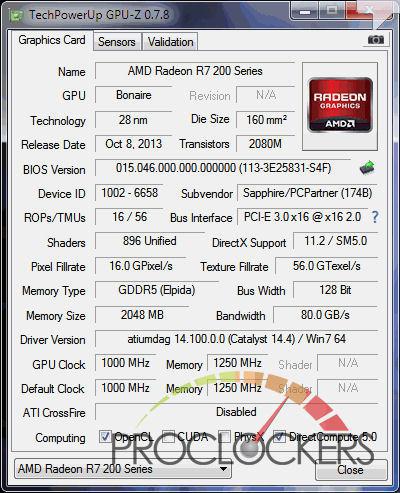
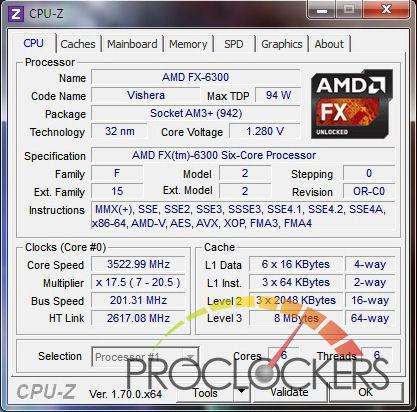
Overclocking
I started overclocking the R7 260X using AMD’s own Catalyst utility. The video card is voltage locked and I was unable to adjust the voltage beyond the power limit of +20%. I tweaked the core speed first and then moved onto the memory speed. At this point the R7 260X was running 1170Mhz on the core and 1550MHz (6200MHz) on the memory. This was an increase of 17% and 24% respectively. On an average, seeing in increase of around 19% percent increase in frame rates, when combinined with the 4.6 GHz clock on the FX-6300 processor in our suite of benchmarks.
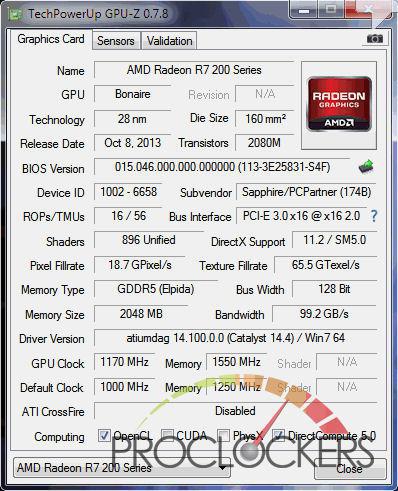
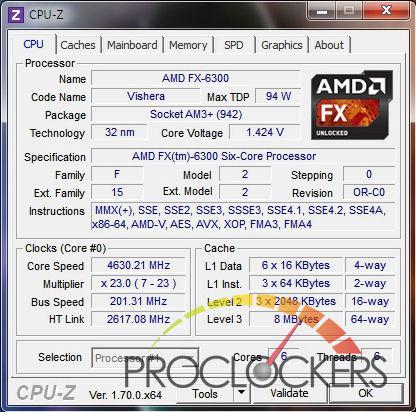
Synthetic Benchmark Results
3DMark – Firestrike
“The new 3DMark includes everything you need to benchmark your hardware. With three all new tests you can bench everything from smartphones and tablets, to notebooks and home PCs, to the latest high-end, multi-GPU gaming desktops. And it’s not just for Windows. With 3DMark you can compare your scores with Android and iOS devices too. It’s the most powerful and flexible 3DMark we’ve ever created.
Fire Strike is a showcase DirectX 11 benchmark designed for today’s high-performance gaming PCs. It is our most ambitious and technical benchmark ever, featuring real-time graphics rendered with detail and complexity far beyond what is found in other benchmarks and games today”
3DMark Chart
Sapphire R9 260X stock speed/ AMD FX-6300 stock speed Graphics Score: 3361
Physics Score: 5538
Combined Score: 1320
Sapphire R9 260X @ 1170 MHz/ AMD FX-6300 @ 4.6 GHz Graphics Score: 1423
Physics Score: 6920
Combined Score: 1470
CINEBENCH R15
“CINEBENCH is a real-world cross platform test suite that evaluates your computer’s performance capabilities. CINEBENCH is based on MAXON’s award-winning animation software CINEMA 4D, which is used extensively by studios and production houses worldwide for 3D content creation. MAXON software has been used in blockbuster movies such as Iron Man 3, Oblivion, Life of Pi or Prometheus and many more.
CINEBENCH is the perfect tool to compare CPU and graphics performance across various systems and platforms (Windows and OS X). And best of all: It’s completely free.”
CINEBENCH R15 Chart
Sapphire R9 260X stock speed/ AMD FX-6300 stock speed Score: 79.86
Sapphire R9 260X @ 1170 MHz/ AMD FX-6300 @ 4.6 GHz Score: 94.73
Game Benchmark Results
Aliens versus Predator
“Bringing the legendary war between two of science-fiction’s most popular characters to FPS fans, AvP delivers three outstanding single player campaigns and provides untold hours of unique 3-way multiplayer gaming.
Experience distinctly new and thrilling first person gameplay as you survive, hunt and prey in the deadly jungles and swamps surrounding the damned colony of Freya’s Prospect. “
Aliens versus Predator is the oldest game in our benchmark suite and the only only that uses DirectX 9.0C versus DirectX 11. Released in 2010, it was developed by Rebellion and published by Sega. It uses the Asura game engine and has the lowest recommended systems requirements in our game benchmark suite.
Aliens versus Predator 1366 x 768 Chart
1366 x 768 / 2 x AA / High Quality Presets
Sapphire R9 260X stock speed/ AMD FX-6300 stock speed Average FPS: 62.3
Minumum FPS: 31.6
Sapphire R9 260X @ 1170 MHz/ AMD FX-6300 @ 4.6 GHz Average FPS: 73.0
Minumum FPS: 31.8
Aliens versus Predator 1920 x 1080 Chart
1920 x 1080 / 4 x AA / Very High Quality Presets
Sapphire R9 260X stock speed/ AMD FX-6300 stock speed Average FPS: 29.2
Minumum FPS: 15.5
Sapphire R9 260X @ 1170 MHz/ AMD FX-6300 @ 4.6 GHz Average FPS: 34.2
Minumum FPS: 18.6
Bioshock: Infinite
“Indebted to the wrong people, with his life on the line, veteran of the U.S. Cavalry and now hired gun, Booker DeWitt has only one opportunity to wipe his slate clean. He must rescue Elizabeth, a mysterious girl imprisoned since childhood and locked up in the flying city of Columbia.”
Bioshock: Infinite, developed by Irrational Games and published by 2K Games, is the third iteration of the Bioshock franchise. It uses the extremely popular Unreal 3 game engine and is one of the best looking games of 2013.
Bioshock: Infinite 1366 x 768 Chart
1366 x 768 / Medium Quality
Sapphire R9 260X stock speed/ AMD FX-6300 stock speed Average FPS: 109.50
Minumum FPS: 29.79
Sapphire R9 260X @ 1170 MHz/ AMD FX-6300 @ 4.6 GHz Average FPS: 127.38
Minumum FPS: 29.76
Bioshock: Infinite 1920 x 1080 Chart
1920 x 1080 / Ultra Quality with Diffusion Depth of Field
Sapphire R9 260X stock speed/ AMD FX-6300 stock speed Average FPS: 30.73
Minumum FPS: 11.15
Sapphire R9 260X @ 1170 MHz/ AMD FX-6300 @ 4.6 GHz Average FPS: 35.76
Minumum FPS: 11.01
Benchmark Results Continued
Dirt 3
“Get ready for DiRT 3! Race through the snow, rain and dirt and experience dramatic night races with the most amount of rally content in the series yet.
Powered by Codemasters’ award-winning EGO Engine, DiRT 3 features Flashback to rewind time and genre-leading damage. DiRT 3 is the ultimate off-road race.”
Codemasters’ 2011 Dirt 3 is possibly the most popular rally racing game ever created. It uses the EGO 2.0 game engine, which is also used in Codemasters follow up to Dirt 3, Dirt: Showdown.
Dirt 3 1366 x 768 Chart
1366 x 768 / 2 x MSSA / Medium Quality Preset
Sapphire R9 260X stock speed/ AMD FX-6300 stock speed Average FPS: 121.77
Minumum FPS: 91.42
Sapphire R9 260X @ 1170 MHz/ AMD FX-6300 @ 4.6 GHz Average FPS: 143.51
Minumum FPS: 102.18
Dirt 3 1920 x 1080 Chart
1920 x 1080 / 8 x MSSA / Ultra Quality Preset
Sapphire R9 260X stock speed/ AMD FX-6300 stock speed Average FPS: 56.30
Minumum FPS: 47.20
Sapphire R9 260X @ 1170 MHz/ AMD FX-6300 @ 4.6 GHz Average FPS: 63.42
Minumum FPS: 52.82
Metro: Last Light
“It Is the Year 2034. Beneath the ruins of post-apocalyptic Moscow, in the tunnels of the Metro, the remnants of mankind are besieged by deadly threats from outside – and within. Mutants stalk the catacombs beneath the desolate surface, and hunt a midst the poisoned skies above.”
Developed by 4A games and published by Deepsilver, Metro: Last Light uses the 4A game engine. At it’s highest settings, the 4A game engine is capable of bringing all but the most extreme gaming systems to their knees.
Metro: Last Light 1366 x 768 Chart
1366 x 768 / Medium Quality / AF 4 / Low Motion Blur / Normal Tesselation / No SSAA / No Advanced PhysX
Sapphire R9 260X stock speed/ AMD FX-6300 stock speed Average FPS: 69.65
Minumum FPS: 17.23
Sapphire R9 260X @ 1170 MHz/ AMD FX-6300 @ 4.6 GHz Average FPS: 86.57
Minumum FPS: 26.05
Metro: Last Light 1920 x 1080 Chart
1920 x 1080 / Very High Quality / AF 16x / Normal Motion Blur / Very High Tesselation / No SSAA / No Advanced PhysX
Sapphire R9 260X stock speed/ AMD FX-6300 stock speed Average FPS: 24.31
Minumum FPS: 9.34
Sapphire R9 260X @ 1170 MHz/ AMD FX-6300 @ 4.6 GHz Average FPS: 28.33
Minumum FPS: 7.01
Thief
“Garrett, the Master Thief, steps out of the shadows into the City. In this treacherous place, where the Baron’s Watch spreads a rising tide of fear and oppression, his skills are the only things he can trust. Even the most cautious citizens and their best-guarded possessions are not safe from his reach.”
Thief was developed by Eidos-Montréal and published by SQUARE ENIX, Eidos Interactive. The newest game in our benchmark suite, Thief is also one of the most demanding and has the highest recommended system requirements. Those heavy requirements allow it to use the Unreal 3 game engine to great effect. It also features AMD’s Mantle API, as well as Microsoft’s common DirectX 11 API.
Thief 1366 x 768 Chart
1366 x 768 / Normal Quality Preset
Sapphire R9 260X stock speed/ AMD FX-6300 stock speed DX11 Average FPS: 43.5
DX11 Minimum FPS: 22.1
Mantle Average FPS: 60.6
Mantle Minimum FPS: 47.8
Sapphire R9 260X @ 1170 MHz/ AMD FX-6300 @ 4.6 GHz DX11 Average FPS: 52.5
DX11 Minimum FPS: 34.7
Mantle Average FPS: 69.1
Mantle Minimum FPS: 55.0
Thief 1920 x 1080 Chart
1920 x 1080 / Ultra Quality Preset
Sapphire R9 260X stock speed/ AMD FX-6300 stock speed DX11 Average FPS: 22.8
DX11 Minimum FPS: 11.9
Mantle Average FPS: 24.4
Mantle Minimum FPS: 20.7
Sapphire R9 260X @ 1170 MHz/ AMD FX-6300 @ 4.6 GHz DX11 Average FPS: 33.5
DX11 Minimum FPS: 18.6
Mantle Average FPS: 34.6
Mantle Minimum FPS: 2.9
Tomb Raider
“Tomb Raider explores the intense and gritty origin story of Lara Croft and her ascent from a young woman to a hardened survivor. Armed only with raw instincts and the ability to push beyond the limits of human endurance, Lara must fight to unravel the dark history of a forgotten island to escape its relentless hold.”
Tomb Raider was developed by Crystal Dynamics and published by SQUARE ENIX, Eidos Interactive. It features a modified version of the Crystal game engine and was the first game to integrate AMD’s TressFX 2.0, which adds hair, fur and grass physics.
Tomb Raider 1366 x 768 Chart
1366 x 768 / Normal Quality Preset
Sapphire R9 260X stock speed/ AMD FX-6300 stock speed Average FPS: 130.6
Minumum FPS: 106.0
Sapphire R9 260X @ 1170 MHz/ AMD FX-6300 @ 4.6 GHz Average FPS: 149.6
Minumum FPS: 120.0
Tomb Raider 1920 x 1080 Chart
1920 x 1080 / Ultra Quality Preset
Sapphire R9 260X stock speed/ AMD FX-6300 stock speed Average FPS: 41.9
Minumum FPS: 33.9
Sapphire R9 260X @ 1170 MHz/ AMD FX-6300 @ 4.6 GHz Average FPS: 48.6
Minumum FPS: 40.8
Temperatures
The Sapphire R7 260X ran a bit on the warm side, but nothing to worry about. The fan profile is on the conservative side. Using Sapphire’s own Trixx utilty does have customizable fan profiles that you can set if you prefer you card on the cooler side.
Temperatures Chart
*Adjusted to 21°C ambient temperature
Sapphire Radeon R7 260X 2GB Idle: 31°C
Load: 74°C
HIS Radeon R7 240 1GB Idle: 37°C
Load: 63°C
XFX Radeon HD 7750 1GB Idle: 36°C
Load: 58°C
EVGA GeForce GTX 760 SC 2GB Idle: 33°C
Load: 62°C
Noise
Noise is a very subjective thing. While measuring dB level of noise can tell you how loud something is, it does not tell you the quality of the noise. Human hearing is the most sensitive in the 4000Hz range. This is roughly the same pitch as a crying newborn baby or the old adage, nails on a chalkboard. The human brain is wired to react to this frequency range and when we are unable to stop the noise, we become agitated.
For this test, the best case scenario is absolute silence. For the worst case scenario, I use the most annoying sounding and loudest video card I have at my disposal, the Nvidia 7600GT. The Sapphire R7 260X was extremely quiet. I rarely every noticed any fan noise while testing and then it was only when the covers were off the test system.
Final Thoughts and Conclusion
The Sapphire Radeon R7 260X 2Gb managed playable performance at 1920×1080 in most modern game titles, often while only having to reduce the settings a bit. At 1366×768 it performed well at every game I through at it. There was not a single game I threw at it that it wasn’t able to handle on some level. Dirt 3 was a joy on the card, easily handling 1920 x 1080 at the highest settings. Tomb Raider only needed the AA turned down a bit. Those are at stock speeds on both the R7 260X and FX-6300 as well.
Once I turned up the clocks on both the R7 260X and FX-6300, things changed quite a bit. The 19% average increase of frames rates allowed me to run some games at higher quality settings and/or with a higher resolution. I was even able to run some older games in Eyefinity. Something of which, I was a bit surprised with. It also ran extremely quiet during all the tests, even at 100% loads.
I rather like the Sapphire Radeon R7 260X 2Gb. I did find the card being voltage locked a bit of a downer, though not a deal breaker. The whole time I was testing and using the card, I kept thinking how it would make a great budget HTPC/Steam Box graphics card. The Sapphire Radeon R7 260X 2Gb can be found for around $120 at Amazon, which is very economical and certainly deserves consideration.
Likes
- Unique Cosmetics
- Good Overclocking Ability
- Well Thought Out Software Package
- Logical Layout
- Very Reasonable Price
Dislikes
- Lack of Voltage Adjustment Limits Advanced Overclocking






